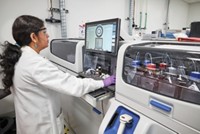Advertisement
Grab your lab coat. Let's get started
Welcome!
Welcome!
Create an account below to get 6 C&EN articles per month, receive newsletters and more - all free.
It seems this is your first time logging in online. Please enter the following information to continue.
As an ACS member you automatically get access to this site. All we need is few more details to create your reading experience.
Not you? Sign in with a different account.
Not you? Sign in with a different account.
ERROR 1
ERROR 1
ERROR 2
ERROR 2
ERROR 2
ERROR 2
ERROR 2
Password and Confirm password must match.
If you have an ACS member number, please enter it here so we can link this account to your membership. (optional)
ERROR 2
ACS values your privacy. By submitting your information, you are gaining access to C&EN and subscribing to our weekly newsletter. We use the information you provide to make your reading experience better, and we will never sell your data to third party members.
Business
There's Money In Safer Food
As concern grows over food recalls, instrument makers eye a growing market for test equipment
by Marc S. Reisch
November 30, 2009
| A version of this story appeared in
Volume 87, Issue 48

Whenever news of another food recall breaks, consumers inevitably scurry to see whether they have the offending item in their refrigerators or pantries. Then they wonder whether the rest of the food in their homes is safe to eat. But the recalls do more than just frighten the public; they are also costly to food producers and distributors.
Domestically, Congress is considering legislation to strengthen food-handling, record-keeping, and safety requirements, and President Barack Obama has promised to back stricter food safety standards. Internationally, governments are increasing scrutiny of food safety controls, both to guarantee growth in food exports and to ensure the safety of domestic supplies. Scientific instrument makers say they have the goods to help support all this enforcement of safety standards.
Given the variety of pesticides, antibiotics, and bacteria that can contaminate food, instrument makers say governments and grocery suppliers aren’t well prepared to safeguard the food supply. The volume of food recalls over the past few years “exposes how inadequate testing is on a global basis, both in government and private companies,” says Gregory J. Herrema, president of the analytical instruments business at Thermo Fisher Scientific.
Agilent Technologies’ worldwide food industry manager, Paul Zavitsanos, points to an additional cause for alarm: The globalization and industrialization of the food supply are “stressing the existing safety system,” he says.

Both executives say increased testing would help prevent contaminated food from ever reaching consumers. A good sign, they say, is that both the government and food processors are testing food more often. Even during the recession, when sales of testing equipment to chemical and pharmaceutical customers have slowed, sales of food testing equipment are growing unabated at 8–12% per year. Equipment makers serve a roughly $2 billion U.S. market for food toxin and pathogen testing.
For instrument makers, food safety testing doesn’t just represent an offset to the slowdown in the chemical and drug testing business, says Isaac Ro, a senior analyst with the investment banking firm Leerink Swann. “Sale of instruments for food testing is a new business opportunity,” he maintains.
Covance, best known as a contract pharmaceutical research organization, says growth of its food safety testing service has surged over the past 18–24 months. In 2007, about 10% of the roughly 300,000 samples coming into its labs from food processors were tested for the presence of bacterial, chemical, and heavy-metal contaminants, recalls Marlo Vasquez, general manager of nutritional chemistry. Today, the firm’s 50,000-sq-ft food testing lab in Madison, Wis., checks 20% of samples for such contaminants. The lab also does nutrient analysis for food and nutritional supplement labeling.
As international trade in food surges, Vasquez sees opportunities to increase Covance’s business with multinational clients. The firm, which has been in the food testing business for 70 years, already has a food testing lab in Singapore, and “we are looking at other possible overseas labs,” he says.
New scrutiny of the food supply by the U.S. Food & Drug Administration and its foreign counterparts is also likely to benefit Covance, Vasquez says. “FDA’s target is to test 5% of imported food, but it only tests about 1% now. New legislation could lead to testing of up to 10% of imported food. So FDA might tap certified labs to support testing for the government,” he says.

Chinese government agencies responsible for exports have invested heavily in testing equipment after scandals involving melamine-contaminated pet food, milk powder, and infant formula, Thermo Fisher’s Herrema points out. “There has been an enormous wave of investment in testing infrastructure in China to rebuild confidence in the quality of food coming out of the country,” he says.
Herrema also sees a big Chinese market for equipment to test food for domestic consumption. Little, if any, of the local food supply is scrutinized for contaminants, he says. “The domestic infrastructure in China represents a growth opportunity,” he adds.
China is not the only country where Thermo Fisher sees growth opportunities. “We are seeing a global wave of investment in food testing equipment,” Herrema says. Japan has significantly improved testing of food imports, particularly after the recent scandal involving insecticide-tainted dumplings from China, he notes. Investments in testing equipment are increasing in other Southeast Asian countries and in Latin America as well, he says, largely to certify exports but also to serve domestic needs.
Agilent, which claims to have a major share of the food chemical analysis market, says it is gearing up to sell more microbiological testing equipment to food customers. Zavitsanos says the globalization of the food supply means that “bacteria from the Congo or Philippines are showing up in Europe and the U.S.”
To offer DNA characterization of contaminants, “we’re bringing our expertise in gene arrays and other life sciences technologies to customers in the food industry,” Zavitsanos says. Opportunities in food are probably not as large as those in pharma and biotech, he acknowledges, but with food testing growing at about 8% per year, it is an attractive market for Agilent.
“Every time there is an outbreak, people realize how important testing is as a component of food safety,” says Adam Greer, a technical support specialist with genotyping expert Idaho Technology. The firm’s polymerase chain reaction (PCR) technology identifies Escherichia coli, Salmonella, and Listeria contaminants in one day or less.
Food processors typically pay contract labs about $40 to test a sample for any one of these bacterial contaminants, Greer explains. But customers would like near-instantaneous results. “It’s a goal but not yet possible with existing technology,” he says.
Manohar Furtado, a scientific fellow at instrument maker Life Technologies, agrees with Greer on the need for speed in PCR. Faster results would allow fresh food to be placed on grocery shelves more quickly and reduce losses due to spoilage, he says. They would also enable regulatory agencies to improve their monitoring of the food supply.
A goal of testing-equipment makers and some food processors is to monitor food as it is processed on a factory line. Scientific instrument makers succeeded in developing automated equipment so the U.S. Postal Service could monitor mail for anthrax spores after a nationwide alert in 2001, Furtado points out. He predicts that a real-time PCR method to monitor food for bacterial contamination on a production line is about two years away from commercialization.
Dionex, for one, already makes a high-performance liquid chromatography system that food makers can install on a production line to test for chemical contaminants. The $100,000 stainless-steel-encased instrument is “mostly used by big manufacturers that can’t wait for results,” says Deepali Mohindra, the firm’s food and beverage market manager. “It’s a decent business, but we’d like to see more orders.”
It’s much more difficult to test solid and semisolid foods on-line than it is to test liquids and gases, explains Terry McMahon, a principal of market research publisher PAI Partners. On-line near-infrared and Raman spectroscopy instruments are now widely used to monitor the quality of petrochemical streams. However, few such instruments are used in the food processing industry, he says. And he doesn’t see why some of the same instruments used to monitor petrochemicals couldn’t be adapted to analyzing foods and beverages for the presence of adulterants.
Yoav Barshad, president of Applied Analytics, says his company supplies mainly petrochemical customers with on-line near-IR and ultraviolet spectrometers. Food processors could avoid a lot of future headaches with on-line analyzers that monitor for contaminants such as antibiotics, aromatics, and mercury, he says.
For example, Perrier could have headed off a global recall of benzene-contaminated spring water in 1990 if it had had UV analyzers sampling the water at its bottling plants, Barshad says. “A lot of food industry companies are cheap,” he says. “They don’t want to create a liability, and they don’t want the on-line record or paperwork that can later be discovered in a court case.” He adds, “There is a real need for legislation to force state-of-the-art on-line testing. We have the technology to do it.”

Experts at NSF International, a food testing and food plant safety certification organization, say large-scale food processors are both a problem and a solution when it comes to food safety. Contamination in a large facility can rapidly become a big problem and lead to recalls and widespread illness, notes Robert Prevendar, director of food safety certification there. But large facilities are also best positioned to protect the food supply, provided that they hew to a clear set of clean-handling and safety standards, Prevendar says. If such facilities also maintain clear records and have recall procedures in place, they’d be well equipped to mitigate the scope of a recall.
It’s not just governments and food processors that are closely examining food-handling and safety procedures today. Retailers want to be assured that they are selling safe foods, too. Beginning in 2000, retailers such as Walmart, Wegman’s, and Trader Joe’s have been part of an effort with food processors and consultants to benchmark safe food-handling standards. The effort, known as the Global Food Safety Initiative (GFSI), encourages food safety testing but only requires it if regulators do as well.
“Testing can’t be the only tool in ensuring safer food,” says Donna Garren, food safety programs vice president for GFSI. Testing is useful, for instance, to identify excessive pesticides or dangerous pathogens when there is a concern they might be present, but other safeguards are important, too, she says.
Food handlers have to ask themselves whether they are receiving and storing food at the right temperature, says Garren, who is a microbiologist. They have to pay attention to sanitary conditions and have a schedule to maintain plant cleanliness. They must also pay close attention to their workers’ health and hygiene to prevent food contamination. “These efforts are all part of a robust safety program,” she stresses.
Walmart, for instance, requires its suppliers of produce, meat, and fish to comply with GFSI-recognized standards such as the Food Marketing Institute’s SQF 2000 food safety and certification program and the British Retail Consortium’s Global Standard for Food Safety.
Garren argues that the large number of food recalls in recent years shows that “companies are doing a good job of identifying problems and recalling problematic food.”
But successful recalls are little comfort to consumers. News travels quickly, and “public opinion continues to push safety concerns,” notes Zoe Grosser, food and environmental markets director for instrument maker PerkinElmer. As a result, many food processors are taking extra precautions, she points out. Some processors that “are purchasing food ingredients from China and North Africa are requiring a certificate of analysis from each supplier,” she says.
Growing concern over food safety means that many large food processors are adding testing capabilities they did not have before, says Susan Steinike, HPLC product coordinator at Shimadzu. Many are modernizing equipment at older labs or adding new equipment to speed up the process of looking at production samples.
Food safety issues and the security issues that concerned people after the Sept. 11, 2001, terrorist attacks on the U.S. have a lot in common, Thermo Fisher’s Herrema says. After Sept. 11, the government and industry made huge investments in the best available technology, ultimately leading to improved real-time capabilities to detect chemical, biological, and explosive threats.
Food processors and governments are now investing in the ability to detect more food-borne contaminants at lower detection limits than were possible just a few years ago, Herrema notes. In national security, as in food safety, he says, “the goal is real-time detection and confidence in the results.”





Join the conversation
Contact the reporter
Submit a Letter to the Editor for publication
Engage with us on Twitter